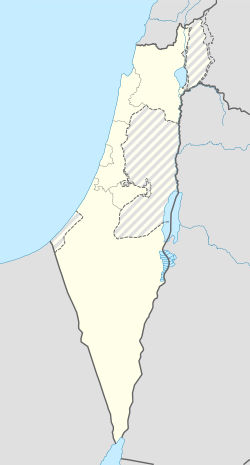|
Amuka, Israel
Amuka (Hebrew: עמוקה, lit. 'Deep') is a community settlement about 6 km northeast of Safed in the Upper Galilee in northern Israel. It belongs to the Merom HaGalil Regional Council. In 2022 it had a population of 159.[1] HistoryAn ancient site in a valley 1 km north of the community is sometimes identified as Kfar Amiko of the Talmud,[2][3] but that identification is generally made with Amqa.[4] As Ammuqa, it had a Jewish population in the early Islamic and Crusader periods and into the 12th century.[5] However, by the 16th century it was a Muslim village.[6] In the early 19th century it was settled by Algerians.[7] In 1948 it was depopulated by the Israeli army.[8] The ancient site is best known as the traditional resting place of Yonatan Ben Uziel who was a student of Hillel the elder, of the first century BCE.[9][better source needed] The first description of the tomb was provided by Yaakov ben Netanel HaKohen in the second half of the 12th century, where he marvels at how the Jews managed to cut the graves into the mountain.[citation needed] Moshe Bassola also visited the site in 1522, and he describes that when he arrived, there was no Jewish settlement there, only graves.[citation needed] A tomb there is the site of annual pilgrimage.[citation needed] The modern community settlement south of the ancient site was established in 1980.[10] EducationChildren in the community attend schools in the nearby city of Safed or other nearby villages: "Nof Harim" elementary school in Sasa, "Anne Frank" high school in Sasa, "Har VeGai" high school, and Einot Yarden high school.[citation needed] Synagogue There is a large ruined building above the burial place of Jonathan ben Uzziel. In the 19th century, the explorer Victor Guérin saw there "the base of a pillar and a number of hewn stones - the remnants of an old structure, possibly a synagogue."[11] Tzvi Ilan writes that today some of the hewn stones are centralized in the center of the ruin like a platform for worship. West of the platform is a rectangular area of 20 by 30 meters appropriate for a synagogue. In the past there was a marble board with a figure of a grapevine.[citation needed] Notable people
See alsoReferences
|
||||||||||||||||||||
Portal di Ensiklopedia Dunia


